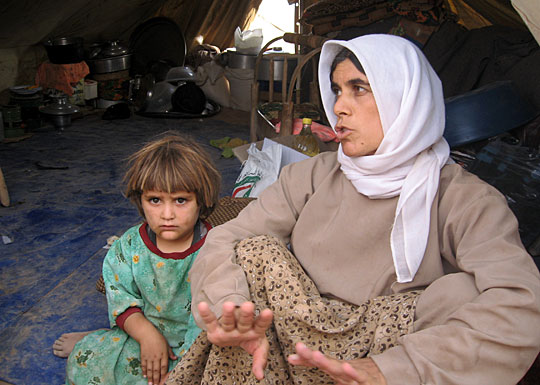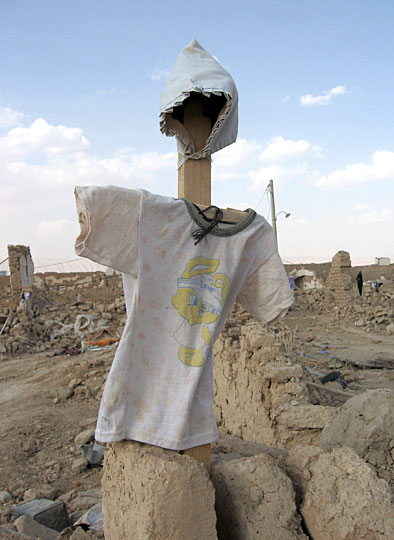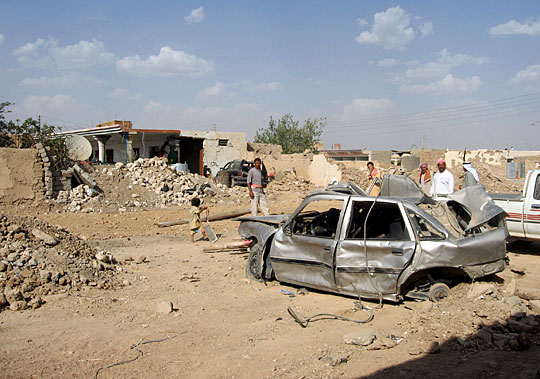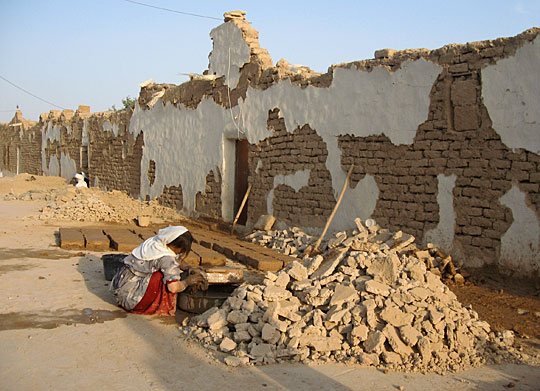
October 5, 2007 by Ivan Watson | Morning Edition
More than a month has passed since four suicide bombers driving trucks filled with explosives attacked two villages in northwest Iraq - killing 310 people and wounding more than 700.

Since the August truck bombings, the administration in Iraqi Kurdistan has dug trench-like fortifications around the Yazidi villages in the desert town of Sinjar. They have also deployed an additional 600 militiamen to protect the villagers.
But those measures have done little to alleviate the fears among the Yazidis, a long-persecuted religious minority of some 600,000 people.
In the devastated Yazidi village of Tel Azer, a crude mannequin serves as a haunting reminder of the massacre there.
A toddler's T-shirt and small hood hang on a wooden frame, erected in the ruins of one of the 800 homes that were flattened by the four truck bombs.
A few miles away, on a street that looks as if it were hit by an earthquake, Khokhay Suleyman squats in the dirt, pounding at the rubble of her house with a hammer.
"We're homeless," she mumbles. "Everything's gone, nothing's left."

Suleyman and the other survivors are still reeling from the attack. Aid is only slowly trickling in, partly because the victims live in an isolated Kurdish-controlled enclave near Sinjar.
The town is surrounded by Arab districts where Iraq's insurgents hold sway. The safest way for Kurdish or Iraqi government convoys to get there is by a long road that's just a stone's throw from the border with Syria.
On one journey into the town, a five-car convoy travels along a road that runs parallel to the Syrian border. Kurdish gunmen in a pickup lead the convoy, and they are nervous. They keep their fingers on their gun triggers, afraid of becoming the target of a roadside bomb or an insurgent ambush.
A Kurdish guard, Khalif Seyder, points out craters and burnt-out cars from previous roadside bombs. He cocks his gun and aims it out the window when the convoy enters the Arab border town of Rhabiye.
"This is the headquarters of the terrorists," Seyder says. "[In] this village, they are all terrorists."
As a long-persecuted religious minority, Yazidis live in fear of future attacks.
Their spiritual leader is a bearded, 74-year-old cleric named Baba Sheikh.
"If they continue attacking us like that [and] if they repeat these attacks two or three more times, they will finish us," Sheikh says.
Twenty-year-old Khudayda Khalid was playing soccer with his brothers when the first bomb went off the day of the insurgent attack. He sprinted home, but he couldn't find his house, because it had been flattened.
"Luckily, I could recognize the bodies of my family members; otherwise, I could not have recognized my house," Khalid says.
Khalid lost his mother, father and 18 other relatives that day.

Today, packs of stray dogs run through the vacant, dirt field that used to be the center of Tel Azer. Authorities filled in the crater [left by the bombs], but the blast also damaged houses three-quarters of a mile away.
Now some residents, like 85-year-old Gawre Halaf, live in government-supplied tents on the edge of the village. Halaf, who is still recovering from shrapnel wounds to her shoulder, says she won't last more than 10 days. She's old and sick, and the winter is coming.
"I'm sure [that] I won't survive," she says.
The Iraqi government paid compensation to many of the village's survivors and distributed some food and mattresses. No money, though, has been given for reconstruction. Some villagers say they have gone more than a month without electricity.

A visiting Yazidi lawmaker from Kurdistan, Mariam Baba Sheikh, expresses outrage at the government's response.
"No one did anything, I know - not the central government, not the Kurdish government," Sheikh says.
The Yazidi religion teaches its followers that, over the centuries, there have been 72 campaigns by outsiders to wipe out the group.
In keeping with Yazidi oral traditions, singers have composed new, haunting ballads. They're trying to remember the most recent attempt to destroy their ancient community
.


